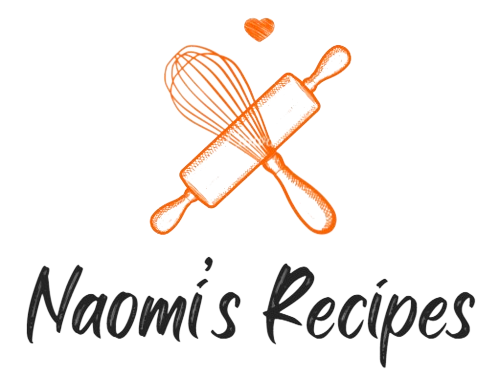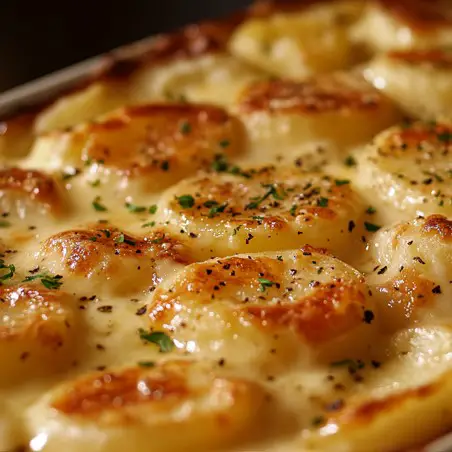Scalloped potatoes are a timeless side dish that combines thinly sliced potatoes with a creamy sauce, making them a perfect addition to any meal. Known for their rich and comforting texture, scalloped potatoes are often served at holiday gatherings, Sunday dinners, and special occasions, making them a family favorite for generations. The dish has a simple yet indulgent appeal, combining basic ingredients like potatoes, cream, and cheese to create something truly irresistible.
What Are Scalloped Potatoes?
Scalloped potatoes are essentially thin slices of potatoes baked in a rich, creamy sauce, often enhanced with cheese, garlic, and herbs. The name “scalloped” refers to the method of layering the potatoes and sauce in a scallop-like pattern, giving the dish its characteristic look and texture.
Why Scalloped Potatoes Are a Comfort Food Classic
The creamy texture and savory flavor make scalloped potatoes the ultimate comfort food. They pair well with various main dishes, from roasted meats to casseroles, and their versatility allows for endless variations.
The History and Origin of Scalloped Potatoes
While the exact origin of scalloped potatoes is unclear, many believe they originated in European cuisine, particularly in France or England. The dish likely evolved as a way to make use of basic pantry staples like potatoes and cream, which were accessible and inexpensive.
Key Ingredients Overview
Each ingredient in scalloped potatoes plays a crucial role in creating the dish’s flavor, texture, and overall appeal. Here’s a breakdown of the main ingredients and their importance:
Russet Potatoes: Best Choice for Creamy Scalloped Potatoes
Russet potatoes are ideal for scalloped potatoes because of their high starch content. This starch helps thicken the sauce, creating a creamier texture during baking. Their fluffy interior also absorbs the flavors of the cream, cheese, and herbs, making them the best choice for this dish.
Heavy Cream: The Secret to Richness
Heavy cream is essential to achieving the luxurious richness of scalloped potatoes. Its high fat content allows it to bind with the starch from the potatoes, creating a thick, velvety sauce that coats every slice. For an even creamier result, some cooks may combine heavy cream with milk or broth.
Parmesan Cheese: Adds Umami and Depth
Parmesan cheese contributes a sharp, savory flavor to the dish. Its umami qualities deepen the overall taste, complementing the creaminess of the sauce and the mild flavor of the potatoes.
Garlic and Thyme: Flavor Boosters
Garlic and thyme bring aromatic notes and a subtle earthiness to the dish. These herbs enhance the creamy base, adding depth without overpowering the simplicity of the potatoes and cheese.
Kosher Salt & Cracked Black Pepper: Enhancing Flavor
Seasoning is key to bringing out the natural flavors of the potatoes and cream. Kosher salt and freshly cracked black pepper help to balance the richness of the dish and add a slight kick.
Unsalted Butter: Adds Moisture and Richness
Butter not only adds richness but also ensures that the layers of potatoes don’t stick together. Its slight sweetness balances the savory elements of the dish, while contributing to the golden, crispy top layer during baking.
How to Slice Potatoes for Scalloped Potatoes
Achieving the perfect scalloped potatoes depends largely on how the potatoes are sliced. The uniformity of the slices ensures even cooking and helps the sauce coat each layer effectively.
Why Thin, Even Slices Matter
Thin, even slices are essential to ensure that all the layers of potatoes cook evenly. If the slices are too thick, they may take longer to bake and could result in a dish where some pieces are undercooked. On the other hand, slices that are too thin can become mushy or fall apart.
Tools for Slicing Potatoes: Knife vs. Mandoline
While a sharp knife can be used to slice the potatoes, a mandoline is highly recommended for consistent, even slices. A mandoline makes it easy to slice the potatoes quickly and uniformly, ensuring that every layer of the dish bakes at the same rate. A thickness of about 1/8 to 1/4 inch is ideal for scalloped potatoes.
Tips for Prepping Potatoes in Advance
If you’re preparing scalloped potatoes in advance, you can slice the potatoes and store them in cold water to prevent browning. Make sure to pat them dry before layering them in the dish to avoid adding extra moisture, which could result in a watery sauce. This method allows you to save time without compromising the quality of the dish.
The Cooking Process
Step-by-Step Recipe Instructions
Making scalloped potatoes requires layering sliced potatoes with a rich, flavorful cream sauce. This step-by-step guide ensures that each layer is perfectly seasoned and baked to golden perfection.
Step 1: Preparing the Sauce
Start by combining 1 ½ cups of heavy cream, four minced garlic cloves, and 1 teaspoon of dried thyme in a medium saucepan. Heat the mixture over medium heat until the cream is warmed through and fragrant, allowing the garlic and thyme to infuse their flavors into the sauce. Stir occasionally to prevent the cream from scorching. This step is essential to ensuring the sauce is rich and flavorful before it’s poured over the potatoes.
Pro Tip: Avoid boiling the cream; it should only simmer to allow the flavors to meld without reducing too much.
Step 2: Prepping the Potatoes
While the cream heats up, peel and clean six medium-sized russet potatoes. Slice them thinly, aiming for about 1/8 to 1/4 inch thickness. Using a mandoline slicer will help achieve consistent thickness, ensuring the potatoes cook evenly.
Pro Tip: Soak the sliced potatoes in cold water to remove excess starch and prevent them from browning. Drain and pat dry before using to avoid adding extra moisture to the dish.
Step 3: Assembling the Dish
Preheat your oven to 375°F (190°C). Butter a pie dish or baking dish to prevent sticking. Begin assembling by laying a single layer of sliced potatoes on the bottom of the dish, slightly overlapping the pieces. Sprinkle a pinch of kosher salt, cracked black pepper, and a thin layer of Parmesan cheese. Pour a small amount of the heated cream mixture over the potatoes. Repeat this layering process three more times, ensuring each layer is evenly seasoned with salt, pepper, Parmesan, and cream.
Pro Tip: For an extra cheesy result, add a thicker layer of Parmesan to the top layer. This will give you a crispy, golden finish after baking.
Step 4: Baking Time
Cover the dish with aluminum foil and place it in the preheated oven. Bake for 50 to 55 minutes until the potatoes are tender when pierced with a fork, and the sauce is bubbling. For the last 10 minutes, remove the foil to allow the top to brown and become golden and crispy.
Pro Tip: Rotate the dish halfway through baking for even cooking.
Step 5: Finishing Touches
Once the dish is fully baked, remove it from the oven and let it rest for at least 10 minutes. This resting period allows the cream to thicken and the flavors to settle, making the dish easier to serve without the sauce running.
Pro Tip: Resist the temptation to cut into the dish immediately; the wait results in a better texture and flavor.
Tips and Tricks for Perfect Scalloped Potatoes
Making scalloped potatoes can be simple, but there are a few common pitfalls to avoid. Here are some expert tips to ensure your dish turns out perfectly every time:
Avoiding Watery Potatoes
To avoid a watery dish, make sure to use starchy potatoes like russets, which help thicken the sauce. Pat the potatoes dry before layering, as excess moisture can dilute the sauce. Also, use heavy cream rather than milk, as the higher fat content prevents the sauce from becoming too runny.
How to Get a Golden Brown Top
The final step of baking without the foil helps the top layer turn golden and crispy. Adding extra Parmesan to the top layer and a few small dots of butter can enhance this effect. Keep an eye on it during the last few minutes to ensure it doesn’t burn.
Preventing Overcooking or Undercooking the Potatoes
Ensure even slicing to prevent some pieces from cooking faster than others. Potatoes sliced too thick may be undercooked, while those too thin can turn mushy. Check the doneness by inserting a fork or knife into the center to see if the potatoes are tender.
Using Other Cheeses for Extra Flavor
While Parmesan is classic, you can experiment with other cheeses for different flavors. Gruyère adds a nutty richness, while cheddar gives the dish a sharper, more intense flavor. Combining multiple cheeses is another way to elevate the dish.
Adding Vegetables for Variety
For added flavor and texture, layer vegetables such as thinly sliced onions, leeks, or spinach between the potato layers. These vegetables blend well with the creamy sauce and add another dimension to the dish.
Common Variations of Scalloped Potatoes
Scalloped potatoes are highly versatile, and you can easily modify the recipe to suit your preferences or dietary needs. Here are a few popular variations:
Adding Meat: Ham or Bacon for a Hearty Dish
Adding diced ham or crumbled, cooked bacon between the layers of potatoes can turn this side dish into a complete meal. The smoky flavor of the ham or bacon complements the creamy sauce, making it perfect for brunch or dinner.
Cheese Variations: Gruyère, Cheddar, or Gouda
Experimenting with different cheeses can change the flavor profile of your scalloped potatoes. Gruyère adds a sophisticated, nutty flavor, while cheddar provides a sharper, tangier taste. Gouda, known for its creamy texture, melts beautifully and adds a subtle sweetness to the dish.
Herb Alternatives: Rosemary, Sage, or Oregano
While thyme is a classic herb for scalloped potatoes, you can swap it for other herbs like rosemary, sage, or oregano. Rosemary adds a pine-like aroma, sage contributes an earthy warmth, and oregano brings a slightly peppery bite.
Vegan or Dairy-Free Options: Using Coconut Milk or Vegan Cheese
For a vegan version, replace heavy cream with full-fat coconut milk, which provides a rich, creamy base. Use vegan cheese alternatives to mimic the cheesy layer, and opt for vegan butter for greasing the dish. Additionally, nutritional yeast can provide a cheesy, umami flavor without any dairy.
FAQs Section: Frequently Asked Questions About Scalloped Potatoes
Can I make scalloped potatoes ahead of time?
Yes, scalloped potatoes can be prepared a day in advance. After baking, allow them to cool, then cover and refrigerate. To reheat, place them in the oven at 350°F for about 20-30 minutes until warmed through. You may want to cover the dish with foil to prevent over-browning.
Can I freeze scalloped potatoes?
Yes, you can freeze scalloped potatoes, but the texture may change slightly. To freeze, bake the dish, cool it completely, and wrap it tightly. When ready to serve, thaw in the fridge overnight and reheat in the oven. Be aware that the cream sauce might separate slightly after freezing.
How do I prevent scalloped potatoes from curdling?
To avoid curdling, use heavy cream instead of milk. The higher fat content in heavy cream helps stabilize the sauce and prevents separation during baking. Also, avoid boiling the cream mixture during preparation.
Why are my scalloped potatoes watery?
Watery scalloped potatoes can result from using low-starch potatoes or adding too much liquid. Be sure to use russet potatoes, which have high starch content, and pat them dry after slicing to remove excess moisture.
Can I add other vegetables to scalloped potatoes?
Yes, you can add vegetables like onions, leeks, or spinach to scalloped potatoes for additional flavor and texture. Layer them between the potato slices for a more complex dish.

Scalloped Potatoes
Description
Scalloped potatoes are a rich and creamy side dish featuring thinly sliced russet potatoes layered with a luscious garlic and thyme-infused cream sauce, topped with Parmesan cheese for a golden, crispy finish. This classic comfort food is perfect for any occasion, whether it’s a holiday feast or a cozy family dinner. The dish is easy to prepare, and the combination of flavors—savory, creamy, and slightly nutty from the Parmesan—makes it a versatile side that pairs well with roasted meats, ham, or even as a stand-alone snack.
Ingredients
- 2 tbsp unsalted butter
- 6 medium russet potatoes, peeled, cleaned, and thinly sliced
- 1 ½ cups heavy cream
- 4 garlic cloves, minced
- 1 tsp dried thyme
- Kosher salt, to taste
- Cracked black pepper, to taste
- ¾ to 1 cup Parmesan cheese, grated
Instructions
Step 1: Preparing the Sauce
In a medium saucepan, combine 1 ½ cups of heavy cream, four minced garlic cloves, and 1 tsp of dried thyme. Cook over medium heat, stirring occasionally, until the cream is hot and fragrant. This step allows the garlic and thyme to release their flavors into the sauce, which will permeate the entire dish.
Note: Be careful not to bring the cream to a boil—just a gentle simmer to prevent the cream from curdling and thickening too much.
Step 2: Prepping the Potatoes
Peel and slice 6 medium russet potatoes into thin, uniform slices (about 1/8 to 1/4 inch thick). A mandoline slicer is highly recommended for achieving even slices, ensuring consistent cooking.
Note: If you’re slicing the potatoes ahead of time, store them in cold water to prevent browning. Just be sure to pat them dry before assembling to avoid adding excess water to the dish.
Step 3: Assembling the Dish
Preheat your oven to 375°F (190°C). Butter a pie or baking dish using 2 tbsp of unsalted butter. Begin layering the potato slices, slightly overlapping each piece to form an even layer. Sprinkle each layer with a pinch of kosher salt, cracked black pepper, and a thin layer of grated Parmesan cheese. Pour a portion of the hot cream mixture over the potatoes, just enough to coat each layer. Repeat the process for a total of 3 to 4 layers.
Note: Be generous with the Parmesan on the top layer for a beautifully browned and crispy finish.
Step 4: Baking Time
Cover the dish with aluminum foil and bake in the preheated oven for 50 to 55 minutes. The potatoes should be tender, and the sauce should be bubbling. For the last 10 minutes, remove the foil to allow the top to turn golden brown and crisp.
Note: You can insert a fork or knife into the center to check if the potatoes are cooked through. If the top is browning too quickly, you can loosely tent the foil to prevent burning.
Step 5: Finishing Touches
Once baked, remove the dish from the oven and let it rest for about 10 minutes before serving. This allows the sauce to thicken and makes the potatoes easier to slice and serve.
Note: Resting also prevents the dish from being too runny when served, ensuring you get the perfect creamy consistency.
Notes
- Choosing Potatoes: For the creamiest texture, always use russet potatoes. Their high starch content helps thicken the sauce and provides a soft, fluffy interior.
- Cheese Variations: While Parmesan adds a classic touch, feel free to experiment with other cheeses like Gruyère, cheddar, or Gouda to suit your taste preferences. A combination of cheeses can elevate the flavor.
- Herbs and Seasoning: Thyme is a wonderful herb to infuse the cream, but you can switch it up with rosemary, sage, or oregano. Fresh herbs will provide a more robust flavor, while dried herbs work perfectly for convenience.
- Making Ahead: This dish can be prepared in advance. Simply assemble, bake, and store in the refrigerator. When you’re ready to serve, reheat in the oven until warmed through.
- Freezing Tips: If you plan to freeze scalloped potatoes, bake them first, then let them cool completely. Wrap tightly in foil or store in an airtight container. To serve, thaw overnight in the fridge and reheat in the oven.
- Vegan Option: For a dairy-free version, substitute the heavy cream with full-fat coconut milk, and use vegan butter and cheese. Nutritional yeast can also add a cheesy flavor without using dairy.









